|
Middleport - a place
suffering from unfilled promises
In his 1910 novel Clayhanger, Arnold Bennett describes the Middleport approaches to Burslem in a most descriptive and eloquent form –“Indian-red architecture… crimson chapels… reddish brown houses.” But towards the residents he was scornful – “Beauty,” he exclaimed, “was achieved, and none saw it.” Beauty in buildings is what Bennett saw – surely there’s more beauty in people?
Before 1800 the village of Middleport existed as fields over which a lane passed from Dale Hall to the pottery of Walter Daniel situated on the side of the Brindley canal. Here Daniel built Newport House and in 1805 he opened a canal spur extending a link to the bottom of Navigation Road thereby opening a direct route to Burslem town centre. Middleport was born.
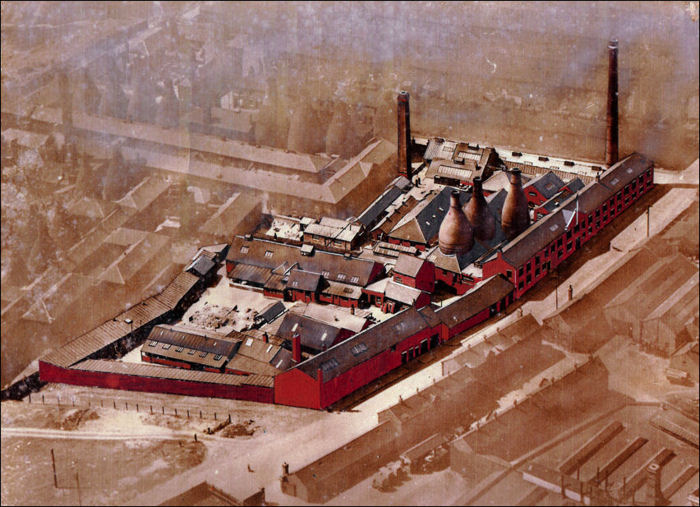
Malkin Tiles, Newport
Pottery c. 1935
If it’s architectural heritage you want there’s still some left in Middleport though you’d better be quick for the ravages of demolition in the interest of so-called progression has taken its toll. Wilkinson’s famous Newport factory – the home of Clarice Cliff – is no more.
Malkin’s Tiles, the Co-op bakery and warehouse and Shelton Bar have all gone. Yes, the model factory of Burgess and Leigh is thriving under the management of William and Rosemary Dorling. And in parallel the giant Steelite is becoming a bigger giant. The plans of overall regeneration under the Housing Market Renewal Pathfinder Prospectus have been launched.
The Port Project designed to reopen Daniel’s canal spur with environmental and retail infrastructure is slowly moving. On paper there’s a lot going on as residents wait and wait and wait – although, it must be said, no longer with bated breath. Middleport is a place suffering from unfulfilled promises, there is no doubt of this.
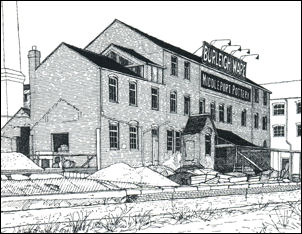
the Middleport Pottery of
Burgess, Dorling and Leigh
Harry Woodward was born in Maddock Street
54 years ago in the house occupied by his grandfather in 1884. He was educated at Middleport schools – recently destroyed in a blaze of suspected arson. As a child he saw the bakery – recently destroyed in a blaze of suspected arson – in full flow and watched as steelworkers marched along the lane to catch the start of their shift.
The terraced houses – some recently destroyed in a blaze of suspected arson – were a handsome feature of the village and complemented a sense of community that was special on this archipelago bounded by the Trent and Mersey canal. He recalls a village that had eight pubs as well as a Workingmen’s club and dozens of corner shops in more self-sufficient and insular times.
Middleport folk were identified by their self-reliance. They were an independent community that needed nothing from nobody – everything they required was at hand. Its motto could have been ‘Stoke on Trent – get lost’ and its coat of arms a steel-worker’s rod crossed with a potter’s carrying board scrolled across a Bizarre Beaker mounted over the back of a stubborn ass.
Harry remembers Middleport with affection. “I lived across from Wood’s Mills. There was a lovely row of worker’s cottages along the lane at the end of which were the luxuries of Ivy Bainbridge’s sweet shop. Ironmongers, shoe repairers, barbers, grocers and greengrocers – you name it, Middleport had it. When school was finished we swam in the canal where the hot water flowed by the Maccaloni Bridge. Played in the most dangerous of locations – on the shordrucks and across the sewerage works where we leaped up and down on a field of grass-covered effluence which we called ‘jelly land’. God only knows what would have happened if the surface had broken
through.”
What about new residents? “Well I have to say there are a number of houses down my street that are occupied by asylum-seekers – Bosnians and the like. They pass by and sometimes they nod a greeting but that’s it. I suppose they haven’t got the hang of the language yet have they?” 
The old co-op bakery
building alongside the bed of the old Burslem Branch Canal
photo: 2001
Newport House, the fine house of Walter Daniel, was demolished in the early 1900’s when the site was acquired for the warehouse and bakery of Burslem Co-op. It was from here that the Co-op bakery supplied bread for thousands of kitchen tables throughout the whole of North Staffordshire, South Cheshire and North Shropshire. These were times of innocence and it’s hard to visualise the gates flying open at 6am after the night-shift-bake as hundreds of horse-drawn vans galloped off in the morning mist to the county shops and worker’s houses carrying hot bread and fresh cakes.
One of the sensual complexities of living in Middleport then must have been the mixture of gorgeous bread aromas, the chemical smells of the ironworks and the smoke of pottery chimneys. Was this the beauty Bennett meant? The Co-op closed down the last of its operations in the 1980’s and in recent times the warehouses were used as a base for a national logistics company. Now the site is slowly being cleared in readiness for the first phase of the Port Project. “I hope it comes off,” says Harry, “The village deserves renewal.” 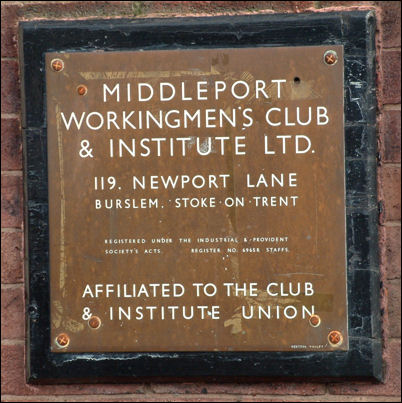
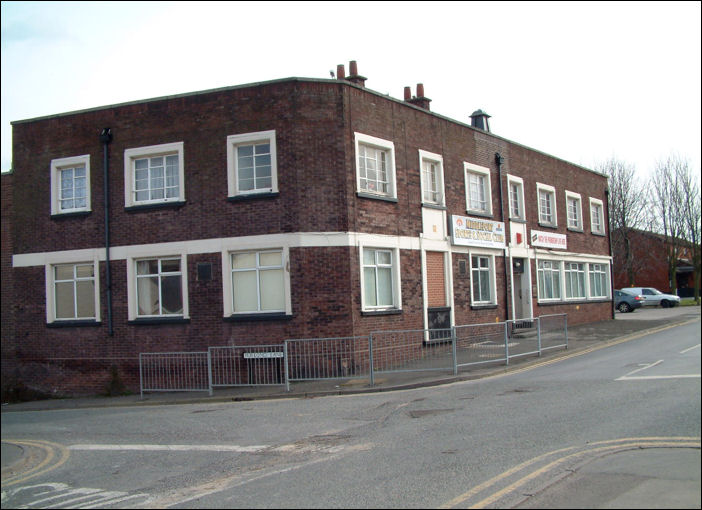
Middleport 'Sports
& Social' Club
corner of Furlong Lane and Newport Lane
The Workingmen’s club was opened in 1920 on the site of a public house called the Five Alls. It has seen good times and like many of its affiliates has experienced more recent bad times. This place was a thriving establishment and underwent massive extensions during the 1970’s to accommodate lucrative variety concerts. Its membership then exceeded more than a thousand and it was in fierce competition with dozens of similar prospering workingmen’s establishment. Along with ‘manual working men’ most of these community venues have disappeared. Yet Middleport club remains – but only just – one of a handful of club and institutes – a dying breed.
Phil Cooper is the current president and I asked him how the club’s future fared.
“We’ve had some really bad times,” he explained, “but we seem to be getting over them. The brewery has shown some confidence in us and we will repay their interest in modernization.”
Phil sees the club as Middleport’s community centre. “We’ve no school and no chapel now and we have to accommodate a new generation. We provide a children’s room and we have meetings here most days for residents. We are a transient community now and that’s affected our custom, but we can’t turn the clock back. We aim to become more of a community centre and there is light at the end of the tunnel. We put on live entertainment at the weekends and the rest of the week we try to give people what they want, mostly they want bingo.”
Wednesday is bingo night and Phil takes his turn calling the numbers. I sit for a couple of ‘houses’ with Doreen Okonski to bring her luck. She’s lived in Middleport for nearly 50 years and wouldn’t swap homes for anything. “I’ve always liked living here,” she says in a strong South Wales accent. “I married my husband here, a coalminer. The neighbours have always been friendly and you could walk into anybody’s house anytime of day or night and be made welcome.”
I point out that there are no strange faces in the club, no asylum-seekers for instance. “No,” she says, “I think they would be made welcome but they keep themselves to themselves. There are some in our street but I don’t see much of them. The biggest problem is with absent landlords who just let the houses rot away.”
Alf Dytche runs the Sunshine Club. “Anyone over fifty or who is unemployed can join,” says Alf. “It used to be the Derby and Joan club so we applied for a small grant to get it going again. The manager of the fund asked me what the objectives were and I said it was for those people who are suffering from a 21st century disease. She was puzzled at first and I explained it was the disease called loneliness – and we got the grant.”
Many of Alf’s members were at Wednesday night’s bingo dotting their numbers hoping to pick up a £25 house or even the £200 jackpot although my presence failed to bring Doreen any luck. Alf believes there’s not a problem with asylum-seekers – “it just needs more supervised integration from the authorities” – that’s all.
“There are a number of houses either side of me with asylum-seekers. There are black families and some from Iraq. They always say hello and are very considerate neighbours. One day they were having a party and asked me if they were making too much noise. They brought me a couple of cans of beer around. They’re OK.”
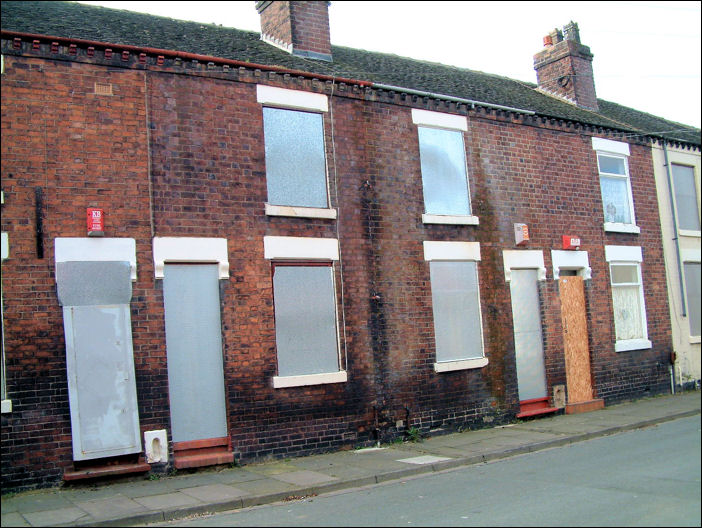
houses in Middleport
waiting for demolition
Although Middleport has always been an inward-looking community it is a place where residents hold out a helping hand to those less well-off, sharing troubles, sharing joy. Heads down, they have always got on with the job of making people welcome and when you’re in, you’re in. These are survivors who have achieved the status of being tough at the sharp end. It is obvious that right-wing politics has no place here where people are treated with equal respect. If there is a place in Stoke on Trent that deserves success and reward for their contribution to community life then it’s Middleport. So why are they waiting?
Fred Hughes

|
![]()
![]()
![]()